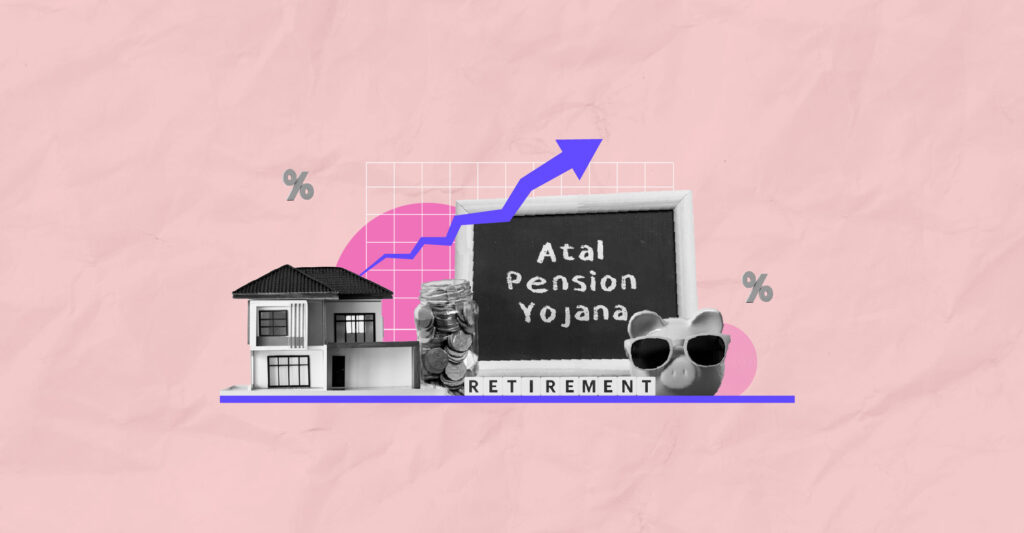Last Updated on Aug 19, 2022 by
A pension plan provides financial coverage post-retirement. Understanding the importance of pensions, the government of India launched Atal Pension Yojana in the 2016-2016 budget. It is specifically designed for the unorganised sector workers in India. In this article, read in detail about Atal Pension Yojana (APY), its features, eligibility, the application process, and the scheme’s benefits.
Table of Contents
What is the Atal Pension Yojana?
As the name suggests, Atal Pension Yojana is a pension scheme that encourages beneficiaries to save for retirement. Under this scheme, a minimum pension of Rs. 1,000, Rs. 2,000, Rs. 3,000, Rs. 4,000 or Rs. 5,000 is paid monthly post-retirement. The pension amount depends on the beneficiaries made by the contributor during the working days and their age. In the APY, the Indian government acts as the co-contributor, and it is one of the risk-free saving schemes in the country.
Features of Atal Pension Yojana
- The pension account of a beneficiary is linked to their bank account. Therefore, the monthly contribution to the scheme is automatically debited from the bank account. The beneficiary must ensure there are enough funds in the bank account for auto-debit to avoid penalties.
- The beneficiary can avail the pension amount only after reaching 60 yrs of age. They are allowed to increase or decrease the monthly contributions once a year.
- A guaranteed pension from Rs. 1,000 to Rs. 5000 is provided depending on the monthly contribution made by the beneficiary.
- The contributions made towards the APY scheme are eligible for tax exemption.
- The government’s contribution towards the scheme is 50% of the beneficiary’s co-contribution amount or Rs. 1,000 per annum (whichever is lower) for 5 yrs. Also, the co-contribution from the Government is provided for individuals not covered by any statutory social security schemes.
- The penalty for late monthly contribution is as follows:
– For a monthly contribution of up to Rs. 100, the penalty is Re. 1 (per month).
– For a monthly contribution of Rs. 100 – 500, the penalty is Rs. 2 (per month).
– For a monthly contribution of Rs. 501 – 1,000, the penalty is Rs. 5 (per month).
– For a monthly contribution of Rs. 1,001 and above, the penalty is Rs. 10 (per month).
If no contributions are made for consecutive 6 months, the account will be frozen. And if it’s in default for 12 months, the account will be deactivated. The amount accumulated and interest will be provided to the account holder in such cases.
Atal Pension Yojana eligibility
The eligibility criteria for the Atal Pension Yojana Scheme are as follows:
- The applicant must be an Indian citizen.
- The applicant should have an active mobile number.
- The applicant must be at least 18 yrs old and a maximum of 40 yrs.
- The applicant must have an active bank account or post office savings account linked with an Aadhaar card.
- Should not be a part of other social welfare schemes like Pradhan Mantri Jeevan Jyoti Bima Yojana(PMJJBY), Pradhan Mantri Suraksha Bima Yojana(PMSBY), Pradhan Mantri Jan Dhan Yojana (PMJDY), etc.
- From 01 October 2022, an Indian citizen who is or has been an income-tax payer will not be eligible for APY.
Swavalamban scheme beneficiaries are automatically eligible for the Atal Pension Yojana and thus migrate to this scheme.
How to apply for Atal Pension Yojana?
You can open the APY scheme account at any bank in India. The Atal Pension Yojana registration steps are as follows:
- Visit the bank at which you have an account already
- Get the APY application form from the authorities
- Duly fill the form with all the mandatory details
- Submit the form along with your Aadhar card copies
- Provide your mobile number
- The bank officials will open the Atal Pension Yojana account and confirm the same
Monthly contribution for Atal Pension Yojana
In the Atal Pension Yojana, the beneficiaries will receive a monthly pension of Rs. 1,000, Rs. 2,000, Rs. 3,000, Rs. 4,000 or Rs. 5,000. This pension amount depends on the age of the beneficiary and the monthly contribution they are making.
Here’s the Atal Pension Yojana chart that explains how much a beneficiary should contribute monthly to get a pension, from Rs. 1,000 to Rs. 5,000.
| Age of the beneficiary | Number of contribution yrs | Monthly contribution (in Rs.) to make for Pension Rs. 1,000 | Monthly contribution (in Rs.) to make for Pension Rs. 2,000 | Monthly contribution (in Rs.) to make for Pension Rs. 3,000 | Monthly contribution (in Rs.) to make for Pension Rs. 4,000 | Monthly contribution (in Rs.) to make for Pension Rs. 5,000 |
| 18 | 42 | 42 | 84 | 126 | 167 | 210 |
| 19 | 41 | 46 | 92 | 138 | 183 | 228 |
| 20 | 40 | 50 | 100 | 150 | 198 | 248 |
| 21 | 39 | 54 | 108 | 162 | 215 | 269 |
| 22 | 38 | 59 | 117 | 177 | 234 | 292 |
| 23 | 37 | 64 | 127 | 192 | 254 | 318 |
| 24 | 36 | 70 | 139 | 208 | 277 | 346 |
| 25 | 35 | 76 | 151 | 226 | 301 | 376 |
| 26 | 34 | 82 | 164 | 246 | 327 | 409 |
| 27 | 33 | 90 | 178 | 268 | 356 | 446 |
| 28 | 32 | 97 | 194 | 292 | 388 | 485 |
| 29 | 31 | 106 | 212 | 318 | 423 | 529 |
| 30 | 30 | 116 | 231 | 347 | 462 | 577 |
| 31 | 29 | 126 | 252 | 379 | 504 | 630 |
| 32 | 28 | 138 | 276 | 414 | 551 | 689 |
| 33 | 27 | 151 | 302 | 453 | 602 | 752 |
| 34 | 26 | 165 | 330 | 495 | 659 | 824 |
| 35 | 25 | 181 | 362 | 543 | 722 | 902 |
| 36 | 24 | 198 | 396 | 594 | 792 | 990 |
| 37 | 23 | 218 | 436 | 654 | 870 | 1,087 |
| 38 | 22 | 240 | 480 | 720 | 957 | 1,196 |
| 39 | 21 | 264 | 528 | 792 | 1,054 | 1,318 |
If the contributions are made regularly, the Atal Pension Yojana maturity amount is as follows:
- For the monthly pension of Rs. 1,000, the indicative corpus is Rs. 1.7 lakh
- For the monthly pension of Rs. 2,000, the indicative corpus is Rs. 3.4 lakh
- For the monthly pension of Rs. 3,000, the indicative corpus is Rs. 5.1 lakh
- For the monthly pension of Rs. 4,000, the indicative corpus is Rs. 6.8 lakh
- For the monthly pension of Rs. 5,000, the indicative corpus is Rs. 8.5 lakh
Atal Pension Yojana scheme withdrawal rules
- The beneficiary can avail the entire corpus amount (receive monthly pension) upon attaining 60 yrs of age.
- The beneficiary can exit the scheme before 60 yrs of age if there is a terminal illness or death.
- In the case of a beneficiary’s death who is below 60 yrs of age, the spouse will receive the pension. The spouse will be given an option to exit the scheme with the accumulated funds or continue to get the pension.
- If the beneficiary exits the scheme before 60 yrs of age, they will be provided with the accumulated amount and the interest.
Atal Pension Yojana tax benefits
- The contributions made towards the scheme are eligible for tax exemption under Section 80CCD of the IT Act, 1961.
- The maximum exemption allowed is 10% of the individual’s gross total income up to a limit of Rs. 1,50,000. An additional exemption of Rs. 50,000 for contributions is allowed.
Atal Pension Yojana benefits
The benefits of the Atal Pension Yojana are as follows:
- The key advantage of this scheme is it provides steady income for individuals post-retirement. This will help them in meeting their basic and medical needs.
- The APY is a government-backed pension scheme. Hence, there is no risk involved.
- This is specifically designed for the unorganised sector workers. It will help them to be financially independent post-retirement.
- In the case of the account holder’s demise, the spouse will be provided with the scheme’s benefits. In the case of the spouse’s death, a nominee will be provided with the accumulated amount.
Atal Pension Yojana vs NPS
Both Atal Pension Yojana and National Pension Scheme (NPS) are government-backed pension schemes in India. The difference between these two schemes is as follows:
| Features | Atal Pension Yojana | NPS |
| Age | 18-40 yrs | 18-55 yrs |
| Who can apply? | Only Indian citizens | Indian citizens and NRIs |
| Government contribution | The government acts as a co-contributor | The government doesn’t not contribute |
| Premature withdrawal | Not allowed unless in the case of medical emergencies | Only tier-2 accounts are allowed |
FAQs
1. Can we apply for Atal Pension Yojana online?
Yes. You can open the Atal Pension Yojana scheme online on the NPS Trust website. You can complete the form online and submit it with the required documents.
2. Can we open Atal Pension Yojana in SBI?
Yes. If you have an account in SBI, you can apply for Atal Pension Yojana at any nearest SBI branch.
3. What is the Atal Pension Yojana age limit?
Eligible Indian citizens who are not a taxpayer and of age 18 – 40 yrs are eligible to apply for the Atal Pension Yojana.
4. Can we apply for the Atal Pension Yojana online in SBI?
Yes. If you have access to the SBI internet banking portal, you can log into your SBI account. Find the Atal Pension Yojana scheme under the ‘Social Security Schemes’ section in the ‘Accounts’ section.
5. What are the Atal Pension Yojana maturity benefits?
The contributor will get a monthly pension of Rs. 1,000, Rs. 2,000, Rs. 3,000, Rs. 4,000 or Rs. 5,000. This can be used to meet basic and medical needs.
6. Where can we get the Atal Pension Yojana form?
You can download the Atal Pension Yojana registration form from the PFRDA website or visit your bank branch to get the form.
7. What is the Atal Pension Yojana customer care number?
The Atal Pension Yojana toll-free number is 1800 889 1030. Keep your PRAN (Permanent Retirement Account Number) in hand while you contact them.
8. Who is not eligible for the Atal Pension Yojana?
– Individuals who are part of other social welfare schemes are not eligible for the Atal Pension Yojana scheme.
– From 01 October 2022, an Indian citizen who is or has been an income-tax payer will not be eligible for the scheme.
9. How to check the Atal Pension Yojana balance?
You can check the Atal Pension Yojana balance by visiting NPS’s official website. Log in with your PRAN or bank account. Along with the balance, you can also get the Atal Pension Yojana statement of the account.
- Long Term Mutual Funds in India (2025) - Oct 29, 2025
- Muhurat Trading in 2025 – Meaning, Benefits, Latest Date and Timings - Oct 8, 2025
- How To Withdraw Mutual Funds? - Jun 6, 2025





